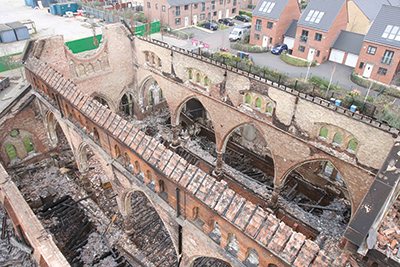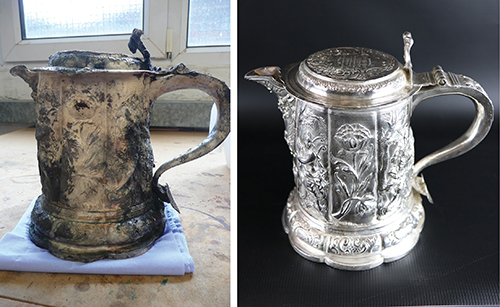Devastating blazes show the importance of fire prevention
 Recent events in Glasgow have undoubtedly brought the issue of fire prevention in to sharp focus for many property owners. After a second devastating blaze in four years, the latest incident at the Glasgow School of Art has destroyed property, displaced students and even impacted local businesses not connected to the school.
Recent events in Glasgow have undoubtedly brought the issue of fire prevention in to sharp focus for many property owners. After a second devastating blaze in four years, the latest incident at the Glasgow School of Art has destroyed property, displaced students and even impacted local businesses not connected to the school.
The first fire in 2014 was caused when flammable gasses from a foam canister came into contact with the hot surface of a projector, sending flames upwards through voids in the walls and old ventilation ducts and completely destroying the iconic Charles Rennie Mackintosh building.
Just four years later and one month before restoration work on the library was due to take place, a second fire took hold causing ‘exceptionally significant’ damage to the structure and the school’s surrounding buildings.
The cause of the second fire is currently unknown, however the first incident may have been preventable and highlights the need for good practice when it comes to fire prevention. Faith Kitchen, heritage director at Ecclesiastical explained: “We know from our own claims experience that, in many cases, the causes of large fires in older properties are often avoidable and we work with our customers to identify best practice and practical advice that they can implement to help reduce the risk.”
“Faulty electrics, sparks from open fires, naked flames and chimney fires are common causes of fire in both commercial and private heritage properties, and while you can never remove the risk completely there are things that can be done to reduce it,” Faith added.
In 2015, a fire thought to be caused by an electrical fault destroyed Clandon Park House in Surrey, leaving just the shell of the original property standing. The property was also home to the Surrey Infantry Museum, which housed a collection of almost 2,300 historic war medals and other famous artefacts including a football famously kicked across No Man’s Land at the Battle of the Somme.
Some three years after the fire, almost 80 per cent of the items have been accounted for, and although many were lost forever, Ecclesiastical is currently working with the museum and specialist restoration company Farcroft to restore over 1,000 medals so that they can be returned to public display.
“One of the reasons the recovery took so long and was so painstaking is that the museum was in the basement of Clandon Park,” explained Paul Humphris, specialist claims consultant at Ecclesiastical. “All the floors above had effectively collapsed on top of it. The fact that some medals have survived is remarkable, considering the extent of the destruction and ferocity of the fire.”
 The insurer says that good housekeeping is the key to reducing the risk of fire from these kinds of events. This includes regular electrical inspections and chimney sweeping, using approved contractors to undertake any electrical work, keeping heat sources such as portable heaters away from combustible materials and making sure that fireplaces have adequate fireguards in place to prevent sparks escaping.
The insurer says that good housekeeping is the key to reducing the risk of fire from these kinds of events. This includes regular electrical inspections and chimney sweeping, using approved contractors to undertake any electrical work, keeping heat sources such as portable heaters away from combustible materials and making sure that fireplaces have adequate fireguards in place to prevent sparks escaping.
“It’s not always practical to install modern fire prevention products in heritage properties,” Faith continued. “You can’t easily retrofit sprinklers or fire suppression systems into these buildings so fire prevention is paramount.
“It’s also really important to make sure you test your fire alarms regularly and ensure that fire detection systems are regularly maintained and that any on-site firefighting equipment is adequate and regularly serviced.”
Most fires are accidental but a small proportion are deliberate. In March 2017, the Church of the Ascension in Salford, Manchester suffered a devastating fire following an arson attack. Within hours Ecclesiastical representatives were on location to secure the site and prevent any further damage, including removing a large stone cross on the gable end to prevent it from crashing to the ground. The insurer hopes to reinstate the original stone cross once the restoration is complete.
It may seem an impossible task but the insurer says there are things that can be done to reduce the risk of arson. “Most incidents of arson are opportunistic,” Faith explained, “so one of the ways you can reduce the risk of arson is to reduce the opportunity. Again, a lot of this comes down to good housekeeping.”
The practical advice given by the insurer includes removing combustible material and rubbish that could be used to start a fire, making sure flammable material is stored correctly and locked away and keeping internal doors shut when a building is not in use to prevent the spread of fire.
“We know that malicious damage such as broken windows and vandalism can often be an early warning sign of arson,” said Faith. “If you experience any of these things, contact the police and your insurer immediately. They will be able to provide advice and guidance on how you can reduce the risk of further damage.”
Ecclesiastical has one of the largest in-house risk management teams in the UK. The team provides in-depth risk management advice that is specifically designed to help owners of heritage properties manage the most common risks to their properties.
Faith concluded: “When a fire takes hold of a heritage property we lose more than just a building and its contents. These buildings often contain some of our most unique treasures, works of art, tapestries and original features that could be lost forever. As a specialist insurer, we believe that preventing the loss of these things is just as important as restoring them after an event but for our customers it’s reassuring that, should the worst happen, Ecclesiastical will be there to help put things right.”
For further information visit www.ecclesiastical.com















